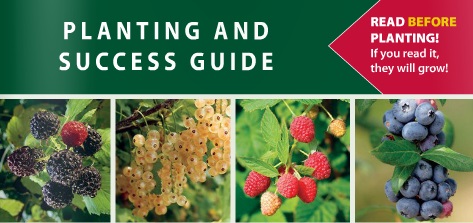The Importance of Scouting
Insect pest management is an important component to successful crop production. The key to an effective pest control program relies on regular monitoring, accurate identification, and proper control timing. Scouting and monitoring for insect pests helps identify and address potential issues before loss occurs or mitigate damage, reduce pesticide usage, and decrease damage to non-pest populations. Monitoring of populations also allows growers to make decisions on applications based on economic thresholds limiting unnecessary pesticide applications.
Regular scouting should begin in early spring and continue weekly/bi-weekly throughout the season. Before beginning a scouting program, identify the key pests for your crop, their development, and the damage caused. When scouting, accurate record keeping is essential. Historical information as well as weather data can be used to track crop and/or pest development stages in relation to temperature and moisture conditions.
Tools for scouting may include a clip board, reference guide/previous scouting notes, camera, hand lens, sweep net, sticky traps, spade or small shovel, knife and hand pruners, disinfectant for hand tools, containers for samples, online/mobile identification/monitoring tools. Many regions have websites and/ or mobile apps to assist growers in pest identification and/or monitoring of populations or conditions suitable for infections.
Fields and greenhouses should be split into manageable sections and scouted separately. Scouts should walk in an X or W pattern to get accurate composite of area; patterns should change with each trip. In each section, select three to five sample points and inspect 10 – 20 plants, or about 100 square feet. Consider separating large fields by variety, age and spacing. All plant parts should be inspected, including leaves (top and underside), stems, roots and flowers and fruit.
For specific pesticide recommendations, please refer to your local extension agent.
Key Pests in Small Fruit & Asparagus
Identification
• Adults about 1/50 inch in length, pale greenish yellow/yellow to dark green or brown, oval shaped
• Two large dark spots on back
• Overwintering females often orange to orange-red
• Eggs are spherical and transparent to yellowish
• Webbing may be present, especially during heavy infestations
Lifecycle
• Prefer temperatures above 80 F with low moisture levels
• Females lay up to 20 eggs per day, up to 120 total
• Larvae hatch in 1 – 2 weeks, depending on temperatures, can be as little as 3 days in hot weather
• Overwinter as adults, or sometimes eggs, on underside of leaves and emerge in early Spring
Host Plants
• Wide host range including strawberries, brambles, blueberries, vegetables, tree fruit, ornamentals and weeds
Damage
• Feeding damage causes stippling on leaves, lack of vigor, stunting, reduced yields
• Silken webbing may be visible
Monitoring period
• Outdoors – Early spring through late fall
• Greenhouses – Year-round
Control
• Maintain healthy plants, spider mites thrive on stressed plants
• Encourage natural predator populations
• Limit insecticide treatments unless necessary, as they can harm predators often increasing spider mite populations
Tarnished Plant Bug
Identification
• Adults about ¼” long, winged and greenish-brown with yellow and black dashes, have a brassy appearance
Life cycle
• Prefer temperatures above 50 F but temperatures above 94F stops/slows development
• Overwinter as adults in protected locations
• Return to field around early bud swell
• Females lay 1 – 3 eggs per day, 30 – 120 total per lifespan
• Eggs are laid in plant tissue
• Nymphs hatch in 5 – 7 days and take up to 40 days to develop into adults, can be as little as 12
Host plants
• Wide host range including strawberries, brambles, blueberries, asparagus, vegetables, tree fruit, ornamentals and weeds
Damage
• Adults and nymphs feed on unopened buds, flowers & tips of young fruit
• Damaged areas of fruit do not develop further, causing misshapen “cat faced” berries
Monitoring period
• Early spring through late fall Control
• Scout flower/fruit clusters beginning at early bloom
• Nymphs can be easily identified by tapping flower clusters into a white cup or bowl
• Insecticide treatment should occur if average nymphs per fruit cluster is greater than one
• Several parasitoids are effective against TPB
Spotted winged Drosophila
Identification
• Adults about 3 mm long. Red eyes, tan body with dark brown bands
• Adult males have a single spot on each wing
• Adult females have a serrated ovipositor, visible under microscope
• Larvae about 1/8”, white cylindrical body that tapers on one end
Life cycle
• Prefer temperatures above 50 F; 94F+ stops/slows development
• Adults live about 2 - 3 weeks, up to 9 weeks in summer
• Females lay up to 100 eggs per day, several hundred total
• Larvae hatch in 1 – 3 days. Take 7 – 10 days to mature into adults
Host plants
• Wide host range of thin-skinned fruits and vegetables including strawberries, brambles, blueberries, cherries, tomatoes, as well as other damaged fruits
Damage
• Females use serrated ovipositor to lay eggs in healthy, ripening fruit
• Larvae feed within fruits causing them to soften and brown
• Damage often not visible until after harvest
Monitoring period
• Active during entire growing season but populations increase with temperatures
• Traps are often used to detect adult presence
Control
• Regular picking, and sanitation, removing overripe/dropped fruit
• Removing wild hosts
• Removing foliage from lower canopy, in brambles
• Regular pesticide applications, 3 – 7 days depending on crop
• Early research on predators increasing
Raspberry Cane Borer
Identification
• Adults: slender, black, long-horned beetles, ½” long, yellow-orange thorax, 2 – 3 black dots
• Larvae: legless, light-colored, ¾” long
Life Cycle
• Two-year life cycle
• Adults emerge in late spring/early summer
• Females puncture cane in 2 rows, 1” apart, 6” below tip of cane
• Eggs are laid in pith of cane between puncture marks
• Larvae hatch and tunnel down the cane
• 1st year Larvae overwinter in the cane close to the girdle
• The following year larvae move through the cane down to the crown
• 2nd year larvae overwinter at or below ground level and complete development the following spring
Host plants
• Brambles: raspberries, blackberries, black raspberries
Damage
• Two rows of puncture marks, 1” apart about 6” below tip of cane
• Tips wilt above punctures
• Cane death can occur if larvae is not removed
Monitoring period
• Late spring through fall
Control
• Prune out wilted tips as soon as they are noticed, ensure canes are cut below larval tunneling
• In heavy infestations, insecticide treatments should target adults pre-bloom
Rednecked Cane Borer
Identification
• Adults: ½” long, slender, metallic blue-black, coppery thorax
• Larvae: flatheaded, white, 5/8” – ¾” long when mature
Life Cycle
• Overwinter as larvae in canes
• Larvae pupate early spring, adults emerge late spring/early summer
• Adults lay eggs on undersides of raspberry leaves
• Larvae hatch in 4 – 24 days
• Larvae chew into cane and tunnel in spiral pattern
• Larvae pupate in 10 – 14 days and emerge as adults
Host plants
• Brambles: raspberries, blackberries, black raspberries
Damage
• Larval feeding causes cane to swell, sometimes forming gall
• Canes weakened often breaking above swelling
Control
• Remove canes showing swelling and destroy them
• In heavy infestations, insecticide treatments should target adults pre-bloom or post-harvest
Strawberry Root Weevil
Identification
• Adult beetles: small dark snouts, rows of pits along backs, 8–12mm
• Larvae C-shaped, legless, white with tan heads, up to 12 mm long
Life Cycle
• Larvae overwinter in soil, pupate early spring, adults emerge late spring/early summer
Host plants
• Strawberries, brambles and some ornamental plants
Damage
• Adult weevils feed on leaves(notching), causing minimal damage
• Larvae feed on roots through winter and spring, causing stunting and poor yields, sometimes death in severe infections
Monitoring period
• Early summer, inspect for adult feeding damage
Control
• Treat soon after adult feeding begins, before egg laying
• Predatory nematodes
Aphids
Identification
• Small sap-sucking insect, typically green, mostly wingless
• Several aphid species can be found on strawberry leaves
• Species ID is important! Damage and control varies by species
Life Cycle
• Overwinter as eggs on underside of strawberry leaves
• Eggs begin to hatch in early Spring
• Adults begin to fly in early summer
• Can be vector for viruses in strawberry
Host Plants
• Wide host range including small fruit, vegetables, trees
Damage
• Honeydew deposition from feeding can cause sooty mold
• Can be a vector for viruses
Monitoring period
• Early spring through late fall Control
• Encourage predator populations
• Limit insecticide treatments unless necessary









